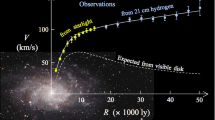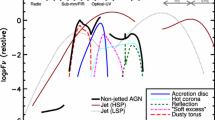Abstract
We review the methodology adopted in computing chemical evolution models of galaxies of different morphological type (ellipticals, spirals and irregulars). We discuss the importance of the history of star formation in different galaxies in order to interpret the observed abundances. In particular, we discuss the time-delay model which allows us to interpret the observed abundance patterns in galaxies as due to the different contributions of supernovae II and Ia. We show that the time-delay model applied to galaxies of different morphological type predicts different [X/Fe] versus [Fe/H] relations in different galaxies. As a consequence of this, these relations can be used to infer the nature and to date high redshift objects. Finally, we show our predictions for the cosmic star formation rate.
Similar content being viewed by others
References
Arimoto, N. and Yoshii, Y.: 1987, A&A 173, 23.
Barbuy, B. and Grenon, M.: 1990, “Bulges of Galaxies”, in: B.J. Jarvis and D.M. Terndrup (eds.), ESO/CTIO Workshop, p. 83.
Barbuy, Ortolani, S. and Bica, E.: 1998, A&AS 132, 333.
Hill, V., François, P., Spite, M., Primas, F. and Spite, F.: 2000, A&A 364, 19.
Calura, F. Matteucci, F. and Vladilo, G.: 2002, MNRAS 340, 59.
Calura, F. and Matteucci, F.: 2003, ApJ 596, 734.
Chiappini, C., Matteucci, F. and Gratton, R.G.: 1997, 477, 765.
Elmegreen, B.: 1999, ApJ 517, 103.
Greggio, L. and Renzini, A.: 1983a, A&A 118, 21.
Greggio, L. and Renzini, A.: 1983b, Mem. SaIt. 54, 311.
Kotoneva, E., Flynn, C., Chiappini, C. and Matteucci, F.: 2002, MNRAS 336, 879.
Haarsma, D.B., Partridge, R.B., Windhorst, R.A. and Richards, E.A.: 2000, ApJ 544, 641.
Hachisu, I., Kato, M. and Nomoto, K.: 1999, ApJ 522, 487.
Iben, I. Jr. and Tutukov, A. V.: 1984, ApJ 54, 335.
Lanfranchi, G. and Matteucci, F.: 2003, MNRAS 345, 71.
Martin, C. L., Kobulnicky, H. A., Heckman, T. M. et al.: 2001, ApJ 574, 663.
Matteucci, F.: 2001, The Chemical Evolution of the Galaxy, ASSL, Kluwer Academic Publisher.
Matteucci, F.: 1994, A&A 288, 57.
Matteucci, F. and Pipino, A.: 2002, ApJ 569, L69.
Matteucci, F. and Greggio, L.: 1986, A&A 154, 279.
Matteucci, F. and Recchi, S.: 2001, ApJ 558, 351.
Matteucci, F. and Tornambè, A.: 1987, A&A 185, 51.
McWilliam, A. and Rich, R.M.: 1994, ApJS 91, 749.
Pettini, M., Rix, S.A., Steidel, C.C., Adelberger, K.L., Hunt, M.P. and Shapley, A.E.: 2002, ApJ 569, 742.
Sommersville, R.S., Primack, J.R. and Faber, S.M.: 2001, MNRAS 320, 504.
Talbot, R.J. Jr. and Arnett, W.D.: 1975, ApJ 198, 629.
Tornambè, A. and Matteucci, F.: 1986, MNRAS 223, 69.
Tinsley, B.M.: 1979, ApJ 229, 1046.
Vladilo, G.: 2002, A&A 391, 407.
Author information
Authors and Affiliations
Corresponding author
Rights and permissions
About this article
Cite this article
Matteucci, F., Calura, F. Chemical Evolution of Galaxies and Nature of High Redshift Objects. Astrophys Space Sci 294, 29–35 (2004). https://doi.org/10.1007/s10509-004-4016-4
Received:
Accepted:
Issue Date:
DOI: https://doi.org/10.1007/s10509-004-4016-4




